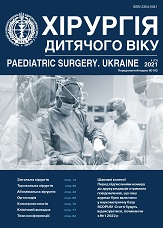Comparative analysis of the skin structure of experimental animals under different types of energy exposure
DOI:
https://doi.org/10.15574/PS.2021.73.13Keywords:
children, pediatric surgery, neviAbstract
Nevi are mostly benign pigmented formations, which, however, in some cases, for some reason, may be subject to malignant transformation. Indications for the removal of nevi of different sizes in general are cosmetic causes, constant irritation of tumors, localization of pigmented nevi in anatomical areas that are difficult to self-control, the presence of nevi particularly prone to malignancy.
The aim is to evaluate, by means of an experimental study, the morphological state and composition of skin tissues in the edges, the bottom of the wound, depending on the nature of the influence of mechanical and energy factors, in order to further determine the tactics of treating nevi in children.
Materials and methods. The choice of guinea pigs as experimental animals, weighing 350–400 g and aged 6–8 weeks, was due to the fact that in mammals of this species the morphological structure of the skin is very close to the structure of human skin, including the structure and location of melanocyte cells. Skin biopsy was taken in two symmetrical relative to the spine areas. After excision of skin biopsies, all animals were kept in individual cages in vivarium, and after 24 hours were divided into 3 groups of 5 individuals each, depending on the method of sampling for further histological examination: group I (n=5) – excision the formation took place in a acute way, with the help of a scalpel; group II (n=5) – excision of the formation was performed using a high-intensity surgical laser «LIKA-surgeon» (output power – 10 W, wavelength – 940 nm); group III (n=5) – excision of the formation using a high-frequency electrosurgical device «BOWA-ARC 350».
Results. The most pronounced morphological and morphometric changes in the tissues of skin biopsies in all terms of the study were determined in animals of the III experimental group, and the minimum in the I group of experimental animals.
Conclusions. Morphological and morphometric studies of skin biopsies of experimental animals with different methods of excision convincingly determined that at all stages of the experiment, minimal tissue damage was inherent in the group of animals in which excision was performed with a scalpel, and maximum pathomorphological changes were observed in biopsy with a monopolar coagulator.
When carrying out experiments with laboratory animals, all bioethical norms and recommendations were observed.
No conflict of interest was declared by the authors.
References
Berg-Knudsen TB, Ingvaldsen CA, Mork G, Tonseth KA. (2020). Excision of skin lesions. Tidsskrift for Den norske legeforening. 140: 10-30.
Cengiz FP, Yılmaz Y, Emiroglu N, Onsun N. (2019). Dermoscopic Evolution of Pediatric Nevi. Annals of Dermatology. 31 (5): 518-524. https://doi.org/10.5021/ad.2019.31.5.518; PMid:33911643 PMCid:PMC7992561
Cuevas RG, Villani A, Apalla Z, Kyrgidis A, Bagolini LP, Papageorgiou C, Lallas A. (2021). Dermoscopic predictors of melanoma arising in small-and medium-sized congenital nevi. Journal of the American Academy of Dermatology. 84 (6): 1703-1705. https://doi.org/10.1016/j.jaad.2020.07.116; PMid:32763328
Elcin G, Yıldırım SK, Gokoz O, Gunaydın SD, Bozdoğan O, Kittler H. (2020). A challenging diagnosis: Recurrent nevus or melanoma. TURKDERM-Turkish Archives of Dermatology and Venereology. 54 (2): 62-65. https://doi.org/10.4274/turkderm.galenos.2019.34270
Hong KT, Lim JM, Lee SE. (2017). A Treatment of Medium-to-Giant Congenital Melanocytic Nevi with Combined Er: YAG Laser and Long-Pulsed Alexandrite Laser. Medical Lasers. 6 (2): 77-85. https://doi.org/10.25289/ML.2017.6.2.77
Maghari A. (2016). Recurrence of dysplastic nevi is strongly associated with extension of the lesions to the lateral margins and into the deep margins through the hair follicles in the original shave removal specimens. Dermatology research and practice. https://doi.org/10.1155/2016/8523947; PMid:27774100 PMCid:PMC5059564
Mutti LDA, Mascarenhas MRM, Paiva JMGD, Golcman R, Enokihara MY, Golcman B. (2017). Giant congenital melanocytic nevi: 40 years of experience with the serial excision technique. Anais brasileiros de dermatologia. 92: 256-259. https://doi.org/10.1590/abd1806-4841.20174885; PMid:28538892 PMCid:PMC5429118
Oliveria SA, Satagopan JM, Geller AC, Dusza SW, Weinstock MA, Berwick M, Halpern AC. (2009). Study of Nevi in Children (SONIC): baseline findings and predictors of nevus count. American journal of epidemiology. 169 (1): 41-53. https://doi.org/10.1093/aje/kwn289; PMid:19001133 PMCid:PMC2720704
Rork JF, Hawryluk EB, Liang MG. (2012). Literature update on Melanocytic Nevi and pigmented lesions in the pediatric population. Current Dermatology Reports. 1 (4): 195-202. https://doi.org/10.1007/s13671-012-0023-9
Soares AS, Manzoni APD, de Souza CDA, Weber MB, Watanabe T, Camini L. (2016). Comparative analysis between sutured elliptical excision and shaving of intradermal melanocytic nevi: a Randomized Clinical Trial. https://doi.org/10.5935/scd1984-8773.201684902
Topaz M, Gurevich M, Ashkenazi I. (2020). Simplified management of a giant forehead congenital nevus allows for early reconstruction. BMJ Case Reports CP. 13 (7): e234164. https://doi.org/10.1136/bcr-2019-234164; PMid:32665278 PMCid:PMC7359177
Zhang LY, Zhang MX, Chen CY, Fang QQ, Ding SL, Xu JH, Tan WQ. (2018). Aesthetic removal of large melanocytic nevi using CO2 lasers with a programmed 4-step approach. International journal of clinical and experimental medicine. 11 (6): 6309-6315.
Downloads
Published
Issue
Section
License
The policy of the Journal “PAEDIATRIC SURGERY. UKRAINE” is compatible with the vast majority of funders' of open access and self-archiving policies. The journal provides immediate open access route being convinced that everyone – not only scientists - can benefit from research results, and publishes articles exclusively under open access distribution, with a Creative Commons Attribution-Noncommercial 4.0 international license(СС BY-NC).
Authors transfer the copyright to the Journal “PAEDIATRIC SURGERY.UKRAINE” when the manuscript is accepted for publication. Authors declare that this manuscript has not been published nor is under simultaneous consideration for publication elsewhere. After publication, the articles become freely available on-line to the public.
Readers have the right to use, distribute, and reproduce articles in any medium, provided the articles and the journal are properly cited.
The use of published materials for commercial purposes is strongly prohibited.

